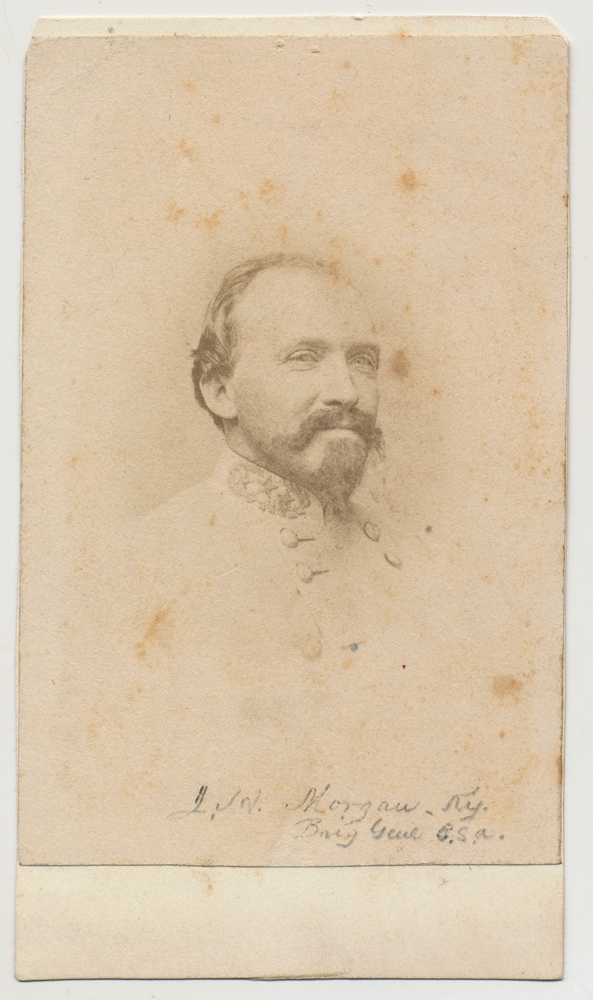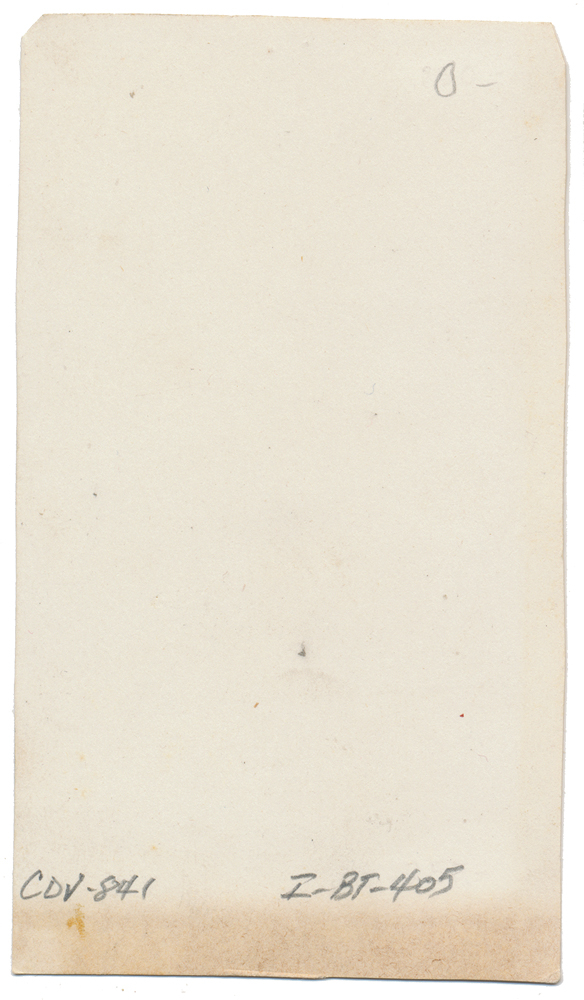site search
online catalog
BUST VIEW OF GENERAL JOHN HUNT MORGAN

Hover to zoom


$900.00
Quantity Available: 1
Item Code: 1138-405
Shipping: Determined by Method & Location of buyer
To Order:
Call 717-334-0347,
Fax 717-334-5016, or E-mail
CDV is of Morgan in a light-colored double-breasted frockcoat with general’s rank on the collar.
Clarity is good but the contrast is a bit light. Paper has light surface dirt and a light period ink ID that reads “J. H. MORGAN, KY. BRIG. GEN. C.S.A.” Top of mount corners are slightly clipped.
Reverse is blank with collector information in pencil at bottom.
From the collection of the late William A. Turner.
John Hunt Morgan was born at Huntsville, Alabama June 1, 1825, but was reared in Kentucky from the age of four years, upon the farm near Lexington to which his parents removed.
His first military experience was at the time of the war with Mexico, when he had the rank of lieutenant in Capt. O. P. Beard's company, General Marshall's cavalry, and in later years he was captain of the Lexington Rifles. During the period following the Mexican War he devoted himself with success to manufacturing.
In September he was arrested by Home Guards while conveying jeans cloth southward from his factory, and imprisoned for three days; and in the latter part of that month he joined the Confederate forces at Bowling, and mustered in November 5th.
He became a colonel in the summer of 1862, when he organized the Second Cavalry at Chattanooga. Then, in July, he won fame by his first Kentucky raid. In August he covered the front of Bragg's army concentrating at McMinnville, Tenn., with victorious engagements at Gallatin and Hartsville.
During Bragg's occupation of Kentucky, part of his men advanced to the Ohio River at Augusta. On October 18th, he captured several hundred Federals at Lexington, after a severe fight. On the return to Tennessee he was given command of a cavalry brigade, composed of his own regiment and the Seventh, Eighth, Ninth and Eleventh Kentucky Cavalry regiments.
On December 7th, he won a brilliant victory at Hartsville. On the 11th he was commissioned brigadier-general. Then followed his "Christmas Raid" in Kentucky, which, with his previous exploits, elicited a resolution of thanks from Congress.
His cavalry division was now formed, the First brigade including the Second, Fifth, Sixth and Ninth Kentucky and Ninth Tennessee regiments; the Second brigade, the Third, Eighth, Eleventh and Tenth Kentucky. Taking position on the right of Bragg's army in middle Tennessee, he fought the enemy at Vaught's Hill, Milton, Liberty, and Snow's Hill, March 19th to April 3rd, and on May 10th defeated the Federals in southeast Kentucky, at the battle of Greasy Creek.
On June 27th, as Rosecrans advanced to force Bragg from Tennessee, General Morgan started out from Sparta, to draw off the Federal strength by an invasion of the Northwest. It happened that his heaviest fighting was in Kentucky.
After a circuit through Indiana and Ohio around Cincinnati, he attempted to re-cross the Ohio River at Buffington Island, July 19th. But after a spirited battle, Colonel Duke and part of his command were captured, and Morgan, with the remainder, forced to continue eastward.
On the 26th, Colonels Grigsby and Johnson, with 300 or 400 men, forded the river, and Morgan himself was halfway across when he saw that most of his men must be captured, and returned to share their fate.
He and his officers were treated rather as criminals than military prisoners, and confined, with the usual indignities, in the Ohio State Prison. But before the end of the year he had escaped with six companions, and passed through Kentucky and Tennessee to the Confederate lines.
In January, 1864, he was given authority to reorganize his command, and in the following month, at his own request, was ordered from Decatur, Georgia, to Abingdon, Virginia. There he had the duty of defending the salt works and lead mines, soon threatened by formidable columns under Crook and Burbridge.
He checked Crook at Wytheville in May, and then made a raid in Kentucky to compel the retreat of Burbridge. On June 8th he took Mt. Sterling and 400 men, and on the 11th captured General Hobson and 1,800 men at Cynthiana.
But Burbridge was in close pursuit, and Morgan was badly defeated on the 12th. Overwhelmed by misfortune, he yet demonstrated his great nature by renewed efforts to defend his territory.
The enemy having penetrated Bull's Gap in August, he was advancing on that post with about 1,000 men when attacked at Greeneville, Tenn., at daylight, September 4th, by Gillem's cavalry. While escaping from the house in which he had passed the night, he was shot and killed. His body, shamefully treated at the time, was afterward interred with honor in the cemetery at Lexington. [ad] [PH:L]
~~~~~~~~~~~~~~~~~~~~~~~~~~~~~~~~~~~
THIS ITEM, AS WITH ALL OTHER ITEMS AVAILABLE ON OUR WEB SITE,
MAY BE PURCHASED THROUGH OUR LAYAWAY PROGRAM.
CLICK HERE FOR OUR POLICIES AND TERMS.
THANK YOU!
Inquire About BUST VIEW OF GENERAL JOHN HUNT MORGAN
Most Popular
Historical Firearms Stolen From The National Civil War Museum In Harrisburg, Pa »
Theft From Gravesite Of Gen. John Reynolds »
Selection Of Unframed Prints By Don Troiani »
Fine Condition Brass Infantry Bugle Insignia »
Large English Bowie Knife With Sheath 1870’S – 1880’S »
Imported (Clauberg) Us Model 1860 Light Cavalry Officer's Saber »
featured item
IMPORT SAXON FIREARM LIEGE MANUFACTURE MODEL 1851 FROM GEORGE ROSENSTEEL’S CIVIL WAR NATIONAL MUSEUM IN GETTYSBURG
This Civil War P.J. Malherbe & Company “Saxon” Percussion Rifle was once part of George Rosensteel’s Civil War National Museum located in Gettysburg, PA on the Taneytown Road. Later the museum incorporated the famous “Electric Map”… (2025-3338). Learn More »
site search
Upcoming Events
The shop is currently closed so that we may conduct our annual inventory. We are available by phone… Learn More »


